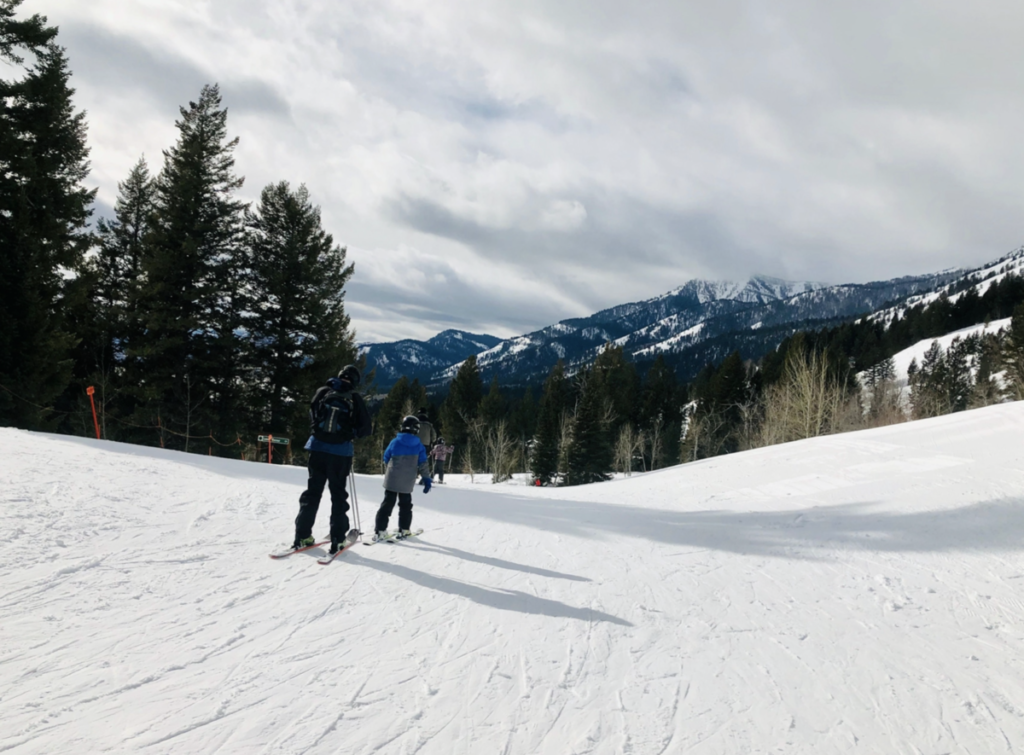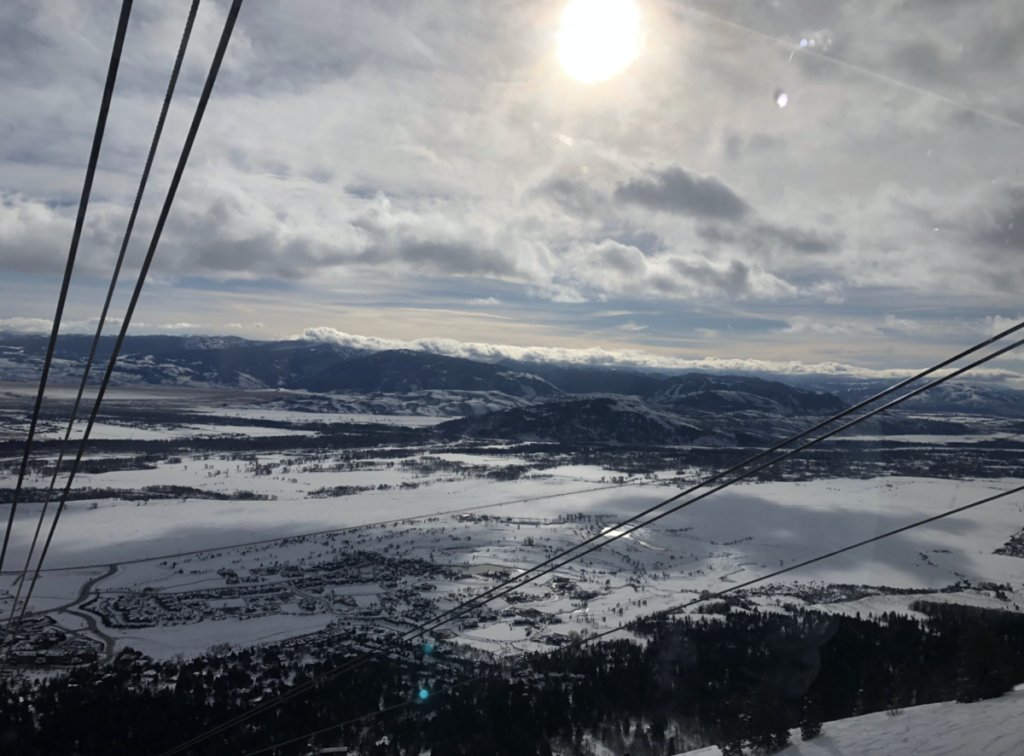
Jackson Hole Mountain Resort (JHMR) is a Four Seasons Resort located in Jackson Hole, Wyoming. JHMR offers a wide variety of amenities for skiers, making it one of the most popular ski resorts in the country. Before diving into the sustainability efforts taken at JHMR, I would like to provide some insight on the topic of sustainability in the ski industry as a whole. Since the early 2000s, “there has been a recent explosion in media and political attention to the issue” of environmental sustainability (Stoddart). This increased awareness of climate change can be attributed to warmer temperatures and more dramatic weather events, such as hurricanes and tornadoes. Unfortunately, climate change is seen by many as a threat to the ski industry. Some skiers have expressed concern that many people don’t seem to care enough about climate change, which makes them worried about the future of their sport. One skier, interviewed in Stoddard’s article, stated that even individual people can do more to make their skiing experience more sustainable. For example, many people view skiing as a time to become one with “mountainous nature,” which seems like an environmentally friendly activity. But by doing this seemingly harmless activity, they are ironically way outside of their footprint. For example, there is a strong link between skiing and automobility, since many skiers drive hours to get to the mountains. This uses an abundance of fuel, especially during the busy seasons. Fortunately, there are ways to combat this transmission.
It has often been said that all sports, to some extent, have a negative impact on our environment. Sports require facilities, which generate energy and contribute to air pollution. Of course, skiing is no exception to this statement, leaving it up to individual resorts to act responsibly and minimize environmental impact. Jackson Hole Mountain resort has gone above and beyond in their sustainability efforts over the past two decades. From reducing automobile emissions to supporting renewable energy to prioritizing alternative fuels, the resort has stood out as a leader in climate change support and education. Especially in an industry such as the ski industry, where climate change poses a huge threat, it is important to raise awareness of energy transmission issues. Jackson Hole has taken many initiatives which have allowed them to emerge as a leader in sustainability amongst ski resorts. However, this multi million dollar task raises a question, amongst historians and skiers alike: is the transition to sustainable skiing worth it? And if so, is JHMR doing enough to stay competitive in the ski industry?
The growing awareness around the issue of automobility has prompted more skiers to consider car sharing or public transportation. In fact, Jackson Hole Mountain Resort has taken steps to reduce automobile fuel transmission. All employees and adult season pass holders are given bus tickets from Teton Village (about 10 miles from the resort). The resort also spent over $1 million on a Park and Ride lot between the town of Jackson and the resort. For further incentive to carpool, JHMR waives the parking fee of cars holding three or more passengers. According to Jackson Hole’s website, it is estimated that these efforts dropped the total miles traveled by each skier by 30%. This saved more than 2000 tons of CO2 emission. Jackson Hole also offers emergency ride share to any of their employees who did drive to work but has to get home for a personal or family emergency. Additionally, as of last year, Jackson Hole implemented an intense process of reviewing all future projects to ensure sustainability within material choices, thus resulting in environmentally sustainable buildings. The resort also began rethinking all purchases: from food to office supplies to merchandise. This was a major step in reducing their overall carbon footprint. As mentioned earlier, Jackson Hole partners with Teton Raptor Center to offer a children’s education program, which increases awareness about climate change and sustainability from an early age.
The transition to environmentally friendly skiing raises a few questions. One question is whether skiers would be willing to pay more for sustainable skiing? As highlighted above, Jackson Hole Mountain Resort spent millions of dollars to reduce overall energy transmissions, which is clearly an expensive endeavor. In a study done in the Journal of Hospitality and Tourism Management (Haugom et. al), skiers were surveyed on their willingness to pay for “Green Skiing.” The results of the study indicated major customer interest in ski passes that take CO2 emissions into account. These “green ski passes” offset the energy used by CO2 with an increased price. Generally, skiers stated that they would be willing to play more to offset carbon transmission, as long as they had a token of recognition for their effort. The article mentions that resorts may choose to give customers who do this a different pass (potentially a green card) to distinguish them from other skiers. JHMR currently does not do this, and may want to consider it in the future to ensure skiers will continue to pay higher prices for sustainable skiing.

Another question raised by the transition to environmentally friendly skiing is: is it worth the money? To answer this question, it is important to first address the issue of sustainability in all industries. According to Professor Knut Haanaes, “62% of executives consider a sustainability strategy necessary to be competitive today, and another 22% think it will be in the future.” Companies in all industries– from Walmart to Adidas– have taken huge jumps toward more sustainable practices, including minimizing waste and reducing their overall footprint. Haanaes states that more companies should follow suit, but with a few practical recommendations. These recommendations include engaging the ecosystem, transparency, and aligning strategy and sustainability. While Haanaes is not directly targeting the ski industry in this article, the ideas relate well. In order for ski resorts to engage their ecosystem, they may pose a threat to the soil and wildlife. As Antonio Rivera discusses in his article, “Forest bird diversity and ski-runs: A case of negative edge effect,” many different kinds of wildlife live on ski resort land. In order to address this issue, and to preserve the environment and the species that live on it, JHMR obtained a special use permit, which allows for habitat management for any animal threatened under the Endangered Species Act. Jackson Hole is also trying to reduce water borne bacteria in its wastewater, including the chemicals from snow making and ice melting. They test their water regularly and monitor for any chemicals. JHMR has decided to draw all of their water for snowmaking (their greatest water demand) from the Snake River Aquifer. A few other sustainability measures taken by JHMR include the goals of achieving absolute municipal waste diversion to composting and recycling greater than 60% by 2025 and reducing hazardous waste production by 10% by 2025. JHMR should keep following Haanaes’ recommendations, in order to stay competitive in the industry.
Another issue that the ski industry faces as a threat to sustainability is the vast use of fossil fuel energy. One of the main energy users at a ski resort is the snow groomer. Used to smooth the surface of snow, the groomer utilizes approximately 5 gallons of diesel per hour. It also produces gasses such as carbon dioxide, nitrogen oxide, and particulate emissions. To combat this issue, Jackson Hole Mountain Resort uses biodiesel in the majority of their trucks and cars. According to their website, starting in 2005, the resort began using B10 fuel, which is comprised of 90% diesel and 10% biodiesel. The fuel contains zero petroleum. The alternative fuel is made from renewable sources and has lower emissions than diesel. The resort also opted to reduce exhaust from snowmobiles by using four stroke snowmobiles, which conserve more energy compared to two stroke snowmobiles. While this sounds good, biodiesel has caused some problems. As highlighted in the article analyzing pros and cons of Biofuel, environmentalists draw concern to the complete switch to biodiesel, since it tends not to fare well in cold weather, which could pose problems for JHMR. Biodiesel can also cause long term machine corrosion, which would be a costly problem with JHMR’s expensive snow groomers.

In 2019, Jackson Hole Mountain Resort announced a full transition to Green Power for all forms of electricity. Specifically, JHMR switched to 100% wind power. In an interview highlighted in the Mountain Watch article, Chief Brand Officer Tyler LaMotte stated that JHMR is “constantly seeking ways to reduce [their] impact on the environment.” As stated in the SkitheWorld article, wind power is ranked by Project DrawDown, the world’s leading resource for climate solutions, as the second best way that people can reduce their environmental impact. Jackson Hole began powering all resort operations through Lower Valley Energy’s (LVE) 100% Green Power program. Jackson Hole is one of only a few resorts to make this transition to 100% wind power. Their partnership with Lower Valley Energy’s Green Power program has excited skiers around the world, all while opening the conversation of sustainability. The switch even prompted many other businesses in Teton County to follow Jackson Hole’s lead and reduce environmental impacts as well. For reference, green power is any type of energy that is produced from sustainable sources (such as the sun or wind). Jackson Hole obtains their energy from Horse Butte Wind farm, which is south of Idaho Falls, about 80 miles south of the resort. Jackson Hole Mountain Resort is known for their ski lifts, especially their Aerial Tram. The tram, launched in 2006, takes about 9 minutes to get to the top of the mountain and holds 100 passengers. Skiers say that when they exit the tram, the first thing they feel is wind on their face. This wind is the same energy that powers the tram they ride. Just one tower at Butte Wind Farm can provide enough electricity to power the tram for 3 years.
JHMR’s transition to 100% Green Power is definitely something to be proud of, but some environmentalists say it still is not clean enough. In his article on the Green New Deal, Merline raises the question: “should hydropower really be considered a clean power source? The simplest answer is ‘sometimes’.” First, he mentions the negative effects that wind power has on ecosystems and wildlife. Approximately 140 wind power transition projects have been blocked due to the harming of wildlife. Next, he states that windmills take too much land to produce power. In fact, they take about 30 times the amount of land as a nuclear power plant. According to a Harvard study, the transition to wind power would take up 12% of United States land, which only accounts for current energy demands. Additionally, wind power can only be used in places where there is enough wind to fuel the wind farm. On top of this, Merline draws attention to the cost of renewable energy. He estimates that, on average, a wind plant costs about 50% more to produce electricity compared to traditional methods. While JHMR’s transition to wind power definitely is more sustainable than traditional energy sources, it is up for debate whether it is worth the amount of land and the cost.
It is clear that Jackson Hole has taken extreme measures to combat climate change, despite being in an industry that relies heavily on environmental waste factors. Despite some environmentalists arguing that wind power is not “green enough”, most skiers agree that they would pay more for sustainable skiing. Skiers from around the world have always been attracted to JHMR for their amazing amenities, but now they have another reason to make the journey out to Wyoming: by doing so, they are helping the sport of skiing for years to come. My one request is that they make the journey via carpool or public transportation!
Bibliography
Butsic, Van, et al. “Climate Change and Housing Prices: Hedonic Estimates for Ski Resorts in Western North America.” Land Economics, vol. 87, no. 1, 2011, pp. 75–91. JSTOR, www.jstor.org/stable/27920304. Accessed 5 May 2021.
Dawson, J., et al. “Climate Change Analogue Analysis of Ski Tourism in the Northeastern USA.” Climate Research, vol. 39, no. 1, 2009, pp. 1–9. JSTOR, www.jstor.org/stable/24870418. Accessed 5 May 2021.
Erik Haugom, Iveta Malasevska, Per Kristian Alnes, Ørjan Mydland. “Willingness to pay for “green skiing”.” Journal of Hospitality and Tourism Management, Volume 47, 2021, pp. 252-255. Science Direct, https://www-sciencedirect-com.proxy.library.emory.edu/science/article/pii/S1447677021000413. Accessed 5 May 2021.
Haanaes, Knut. “Why All Businesses Should Embrace Sustainability.” Accessed 14 May 2021.
https://www.imd.org/research-knowledge/articles/why-all-businesses-should-embrace-sustainability/
Hudek, C., Barni, E., Stanchi, S. et al. Mid and long-term ecological impacts of ski run construction on alpine ecosystems. Sci Rep 10, 11654 (2020). Accessed 14 May 2021. https://doi.org/10.1038/s41598-020-67341-7.
Kirschner, Lisa A., and Alysa M. Keller. “Ski Industry Response to Global Warming.” Natural Resources & Environment, vol. 22, no. 1, 2007, pp. 53–55. JSTOR, www.jstor.org/stable/40924883. Accessed 5 May 2021.
Laiolo, P., & Rolando, A. (2005). Forest Bird Diversity and Ski-Runs: “A Case of Negative Edge Effect.” Animal Conservation, vol. 8 no. 1, 2005, pp. 9-16. Cambridge University Press, https://www.cambridge.org/core/journals/animal-conservation-forum/article/abs/forest-bird-diversity-and-skiruns-a-case-of-negative-edge-effect/8D6E85476335539DC31BACC0829996F4. Accessed 5 May 2021.
Masjuki Hj. Hassan, Md. Abul Kalam. “An Overview of Biofuel as a Renewable Energy” Source: Development and Challenges, vol. 56, pg 39-56. https://doi.org/10.1016/j.proeng.2013.03.087. Accessed 14 May 2021.
Merline, John. “Green New Deal: Is 100% Renewable Energy Even Possible, Or Good For The Environment?” Accessed 14 May 2021 https://www.investors.com/politics/commentary/renewable-energy-possible-good-environment/
Negus, Norman C., and James S. Findley. “Mammals of Jackson Hole, Wyoming.” Journal of Mammalogy, vol. 40, no. 3, 1959, pp. 371–381. JSTOR, www.jstor.org/stable/1376561. Accessed 5 May 2021.
Pastore, Christopher L. “Skiing Turns Through the Timber: Cutting a Trail toward Multi-Use, Ecological Forestry.” Northeastern Naturalist, vol. 24, 2017, pp. H22–H44. JSTOR, www.jstor.org/stable/26453941. Accessed 5 May 2021.
Pickering, Catherine Marina, and Ralf C. Buckley. “Climate Response by the Ski Industry: The Shortcomings Of Snowmaking for Australian Resorts.” Ambio, vol. 39, no. 5/6, 2010, pp. 430–438. JSTOR, www.jstor.org/stable/40801536. Accessed 5 May 2021.
Robert Steiger, Eva Posch, Gottfried Tappeiner, Janette Walde. “The Impact of Climate Change on Demand of Ski tourism – A Simulation Study Based on Stated Preferences.” Ecological Economics, Volume 170, 2020. Science Direct, https://www-sciencedirect-com.proxy.library.emory.edu/science/article/pii/S0921800919315344. Accessed 5 May 2021.
Sam Spector, Chris Chard, Cheryl Mallen, Craig Hyatt. “Socially Constructed Environmental Issues and Sport: A Content Analysis of Ski Resort Environmental Communications, Sport Management Review.” Volume 15, Issue 4, 2012, Pages 416-433. Science Direct, https://www.sciencedirect.com/science/article/abs/pii/S1441352312000472. Accessed 5 May 2021.
Scott, Daniel, et al. “Climate Change and the Sustainability of Ski-Based Tourism in Eastern North America: A Reassessment.” Journal of Sustainable Tourism, vol. 14, no. 4, July 2006, pp. 376–398. https://www.researchgate.net/publication/249023792_Climate_Change_and_the_Sustainability_of_Ski-based_Tourism_in_Eastern_North_America_A_Reassessment. Accessed 5 May 2021.
Stoddart, Mark C.J. “‘If We Wanted to Be Environmentally Sustainable, We’d Take the Bus’: Skiing, Mobility and the Irony of Climate Change.” Human Ecology Review, vol. 18, no. 1, 2011, pp. 19–29. JSTOR, www.jstor.org/stable/24707683. Accessed 5 May 2021.
Williams, Peter W., and Susan E. Todd. “Towards an Environmental Management System for Ski Areas.” Mountain Research and Development, vol. 17, no. 1, 1997, pp. 75–90. JSTOR, www.jstor.org/stable/3673916. Accessed 5 May 2021.
Thank you to Professor Miller and all of our guest speakers in History 385. It was an enriching class experience!
